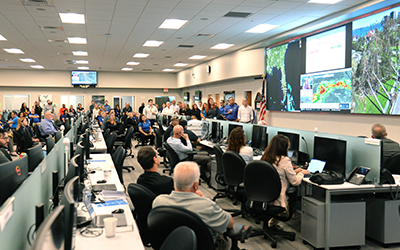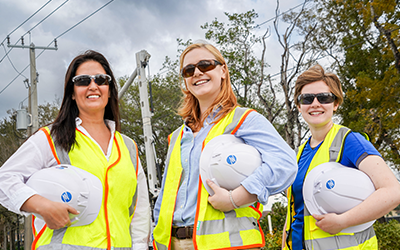
JUNO BEACH, Fla. -- Growing up in Indiana and then living in Oklahoma -- the heart of tornado alley -- for 15 years, Chris Kerr witnessed just how quickly skies can turn from calm to chaos.
He can vividly recall the roaring winds that came with each deadly storm, especially the last EF5 (strongest classification of tornadoes) on record in the U.S. that affected his friends and coworkers in May 2013, but barely missed his home.
These memories, etched into his soul, fuel his dedication as a meteorologist today at Florida Power & Light Company (FPL). From afternoon thunderstorms to named hurricanes, he forecasts weather conditions to help restoration crews get the lights back on safely and quickly for customers by informing them of any threats or challenges they may face, like lightning, high winds, storm surge or flooding.
“I like being able to see the results from the forecasts and being able to make a difference,” said Kerr while looking through weather tracking models on his various computer screens. The graphics software he and his colleague, Tim Drum, use is just like what the Weather Channel and other media entities use to present graphical weather forecasts.
This accurate and timely weather forecasting is crucial, especially as experts predict a well-above-average 2024 hurricane season beginning June 1. Researchers at Colorado State University are forecasting 23 named storms, 11 hurricanes and five major hurricanes.
“All the data coming in so far shows this season could possibly be one to challenge some of the records set in recent years,” said Kerr. “Record-high water temperatures out in the Atlantic Ocean and an anticipated La Niña are two factors that are favorable for hurricane development.”
La Niña is the periodic cooling of the waters of the central and eastern equatorial Pacific Ocean; and it typically allows for above average tropical cyclone development in the North Atlantic Ocean because of increased thunderstorms and reduced wind shear. Tropical cyclones become stronger when they pass over warm water and areas of low wind shear.
By July or August, weather models show La Niña will likely develop and become moderate to strong around the peak of the hurricane season (September to October).

FPL tests readiness with simulated storm
Regardless of conditions, FPL is better prepared for hurricanes than at any time in the company’s history through its year-round improvements to make the energy grid smarter, stronger and more storm resilient.
These investments, including the deployment of smart grid devices and installation of underground power lines, benefit customers by reducing outage times and restoration costs associated with severe weather events.
FPL also prepares for hurricane season by stress-testing employees with a week-long, simulated hurricane response, typically in the early days of May just as the start of hurricane season comes into view.
While the storm is fictitious, FPL’s response is not. The training scenario feels every bit as real, in part, because of detailed weather forecasts and simulated impacts to the state.
“I put together mock scripts and simulated weather shows from our studio to imitate a real-world situation. We take lessons learned from these drills and previous storms to continue improving our response,” said Kerr.
His realistic weather updates are relayed to Distribution Operations Manager Casey Sheffield, who oversees the deployment of resources (crews, trucks, and equipment) during day-to-day operations.
“During a real storm, the command center team can pre-stage thousands of resources while allowing crews to continue working until Kerr informs us of unsafe weather conditions,” said Sheffield. “At the end of the day, the goal is to always cut down on restoration times for our customers."
The drill is a comprehensive test of FPL's storm response capabilities. It involves most departments within the company, such as customer service and communications, ensuring that everyone is aligned and ready to act quickly and safely in the event of a real storm.
"Being part of this drill reminds me of the responsibility we have to our customers. We want them to be prepared for anything mother nature may bring this hurricane season, just as we are,” said Kerr.
FPL urges customers to be aware of potential safety hazards, especially before, during and after severe weather. Customers can find tips on how to prepare on FPL.com/Storm.




